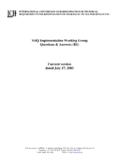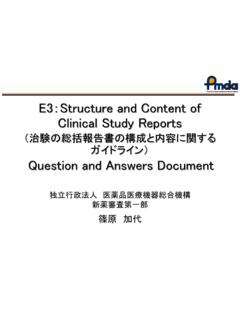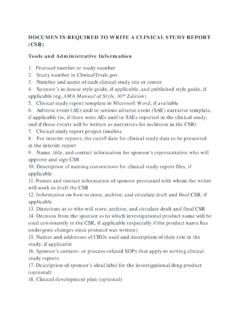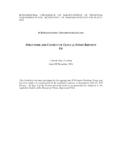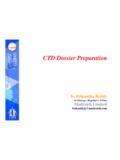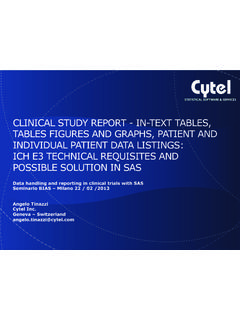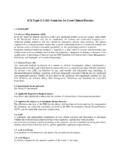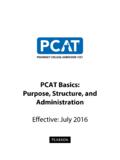Transcription of E3 Implementation Working Group ICH E3 Guideline ...
1 International Conference on Harmonisation of Technical Requirements for Registration of Pharmaceuticals for Human Use ICH Secretariat, Chemin Louis-Dunant 15, Box 195, 1211 Geneva 20, Switzerland Telephone: +41 (22) 338 32 06, Telefax: +41 (22) 338 32 30 E3 Implementation Working Group ICH E3 Guideline : structure and content of Clinical Study Reports Questions & Answers (R1) Current version dated 6 July 2012 In order to facilitate the Implementation of the E3 Guideline , the ICH Experts have developed a series of Q&As: E3 Q&As Document History Code History Date E3 Q&As Approval by the ICH Steering Committee under Step 4 7 June 2012 E3 Q&As (R1) Correction of minor typographical errors in the Answer to Question 6: Section was replaced by Section in the second and third paragraphs. 6 July 2012 Reference ICH E3 structure and content of Clinical Study Reports November 1995 Last Update : 6 July 2012 E3 Q&As (R1) i TABLE OF CONTENTS 1.
2 content AND structure .. 1 2. APPENDICES .. 3 3. TERMINOLOGY .. 4 Last Update : 6 July 2012 E3 Q&As (R1) 1 E3 Questions and Answers (R1) 1. content AND structure Date of Approval Questions Answers 1 June 2012 Some in the pharmaceutical industry have expressed concern that the ICH E3 Guidance, structure and content of Clinical Study Reports (hereafter, E3), is intended as a requirement, , a template that must be followed. The fact that the ICH M4 Guidelines for the CTD refer to specific structural elements described in E3 ( , Clinical Study Report [CSR] section headings) may have contributed to this interpretation. Interpretation of E3 as a rigid template can result in presentation of redundant and suboptimal information in CSRs. This is a particular problem when E3 is used for studies for which it was not designed ( , pharmacokinetic studies or studies with health economic or quality of life outcomes).
3 Can ICH reaffirm that E3 is a Guideline and not a required template and that E3 may be adapted to report studies that fall outside the original scope of E3? Yes. ICH E3 is a Guideline , not a set of rigid requirements or a template, and flexibility is inherent in its use. The Guideline is intended to assist sponsors in the development of a report that is complete, free from ambiguity, well organized, and easy to review. Modifications and adaptations to the structure presented in the Guideline that lead to better display and communication of information are encouraged. The introduction to E3 (page 2) clearly indicates that E3 is to be interpreted as a Guideline , not a set of requirements: Each report should consider all of the topics described (unless clearly not relevant) although the specific sequence and grouping of topics may be changed if alternatives are more logical for a particular study.
4 Some data in the appendices are specific requirements of individual regulatory authorities and should be submitted as appropriate. The numbering should then be adapted accordingly. To illustrate this flexibility, consider demographic baseline information. E3 suggests presentation of this information in the efficacy evaluation, but many variations of this presentation are possible. For example, if the efficacy and safety populations differ substantially, it would be appropriate to present demographic and baseline characteristics for the safety and efficacy populations in the safety and efficacy sections or in a new section preceding the efficacy and safety results sections. If particular types of information or topics are not addressed in E3 or if their location is not specified, this information or topic should be placed in the section that is most relevant.
5 For example, pharmacokinetic or quality of life results could be placed in appropriately identified subsections of the efficacy and safety results sections, or they could be Last Update : 6 July 2012 E3 Q&As (R1) 2 placed in new, appropriately identified results sections. If a report does not address all the aspects of E3 that are relevant for a given study, this should be clearly indicated and the rationale for doing so should be provided, for example, if there is no presentation of efficacy for an efficacy study. A rationale is not necessary if sections presented in E3 are re-ordered, renamed, or deleted (if warranted by the study design) or if new sections are added. It should be noted that E3 was developed for submission of adequate and well-controlled clinical effectiveness studies. Nevertheless, the basic principles described can be applied to other kinds of trials, such as clinical pharmacology studies and open-label safety studies, recognizing that not all sections or data presentations may be appropriate or needed for these other types of trials.
6 Sponsors are encouraged to adapt the recommendations in the Guideline as needed ( , by deleting sections that are not relevant or adding needed sections that are not mentioned in the Guideline ). 2 June 2012 The ICH E3 Guideline provides limited guidance on the synopsis. In the ICH M4E Guideline , additional guidance on the synopsis of a CSR is given including its use as a stand-alone document and its length. While E3 asks for a usual maximum length of 3 pages, M4E extends this page limit for more complex and important studies, , to 10 pages. How should both Guidelines be read together? The guidance given in the ICH E3 Guideline , which was developed before M4E, should be combined with the suggestions made in the M4E Guideline . Since the synopsis will be used as a stand-alone document within a Common Technical Document, it should be written so that it can be understood and interpreted on its own, , without the other sections of a CSR.
7 In addition to a brief description of the study design and critical methodological information, the synopsis should provide efficacy and safety results, as well as other critical information including data on the study population, disposition of subjects, important protocol deviations, and treatment compliance. Cross-references to other sections of the CSR should be avoided. As explained in M4E, complex or large and important studies may require a synopsis longer than 3 pages. The 10-page example given in M4E is not an absolute requirement or limit but should not need to be exceeded considerably. The use of a tabular format for the synopsis is not mandatory. Last Update : 6 July 2012 E3 Q&As (R1) 3 2. APPENDICES Date of Approval Questions Answers 3 June 2012 The CSR appendices described in the ICH E3 include material now available in the Trial Master File (TMF) in accordance with ICH E6.
8 Do documents available in the TMF need to be included in the CSR appendices? Documentation needed to review the CSR should be included in the CSR appendices. It is not sufficient for such documents to be included only in the TMF, which is not submitted in the marketing application. Documents that provide critical information on a study, such as the protocol ( ), statistical methods ( ), list of investigators and study sites and sample case report forms, would always be needed by reviewers assessing a study and should be included in the trial report even if they are in a TMF. Certain documents may be required for the CSR by individual countries or regions, in which case they should be included. For example, according to ICH-GCP, an audit certificate ( ) should be provided when required by applicable law or regulation. If there is any uncertainty about whether documents should be included or not, the appropriate regulatory agency may be consulted.
9 Supportive documents, such as investigator CVs, ethics committee approvals, informed consent forms, and batch numbers per subject are in the TMF or clinical supply database and should generally not be included in the CSR appendices. Any documents not submitted and subsequently requested by the regulatory authority would be expected to be provided promptly. 4 June 2012 How can I include data not mentioned in the ICH E3 text or Appendices since the Guideline pre-dates the ICH M4 Guidelines associated with the CTD and eCTD? Specifically, what are the options for submission of data for topics such as pharmacokinetics, pharmacodynamics, pharmacogenomics (genomic markers), gene therapy, stem cells, biomarkers, devices, It is appropriate to create new headings in the CSR and new Appendices for these topics.
10 The Guideline provides for and focuses on Efficacy and Safety variables known at the time. Other topics should be well referenced in the CSR body and clearly identified in the Table of Contents. Current submission options include: 1) Stand alone reports. These can be placed in parallel with the main clinical study report in the eCTD. For example, a clinical pharmacology study might have the clinical study report, a PK Last Update : 6 July 2012 E3 Q&As (R1) 4 quality of life, assay validation, data monitoring/review committees, electrocardiogram, other safety reports, images, pictures/scans, diagnostic tests for individualized therapy, and patient-reported outcomes? report, and an assay validation report. For an efficacy study with patient reported outcome (PRO) measures, there might be a PRO report.
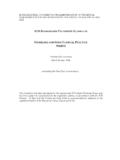
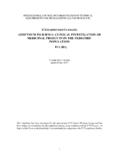
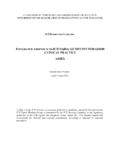
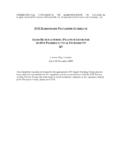
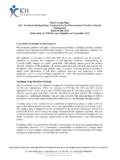
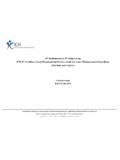
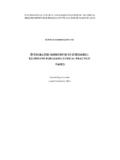
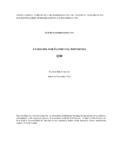
![[ICH E2F] [EXAMPLE DSUR – PHASE III …](/cache/preview/1/3/5/f/e/1/c/f/thumb-135fe1cf2cdb82799c462ad0ea089c48.jpg)
